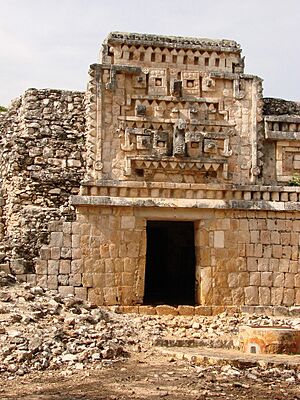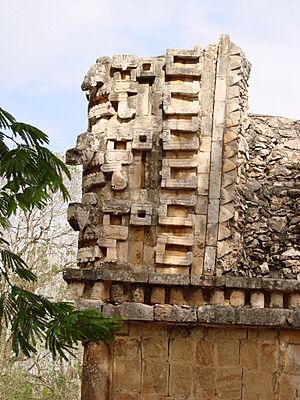Xlapak facts for kids
Xlapak (also called Xlapac) is a small, ancient city built by the Maya people. You can find this amazing archaeological site in the southeastern part of Mexico, on the Yucatan Peninsula. It sits right in the middle of the Puuc region, which is famous for its unique style of Maya buildings.
Xlapak is about 4 kilometers (2.5 miles) away from two other important Maya sites, Labná and Sayil. It's located in a valley within the Puuc Hills, in the state of Yucatán. This area is mostly made of karst limestone, which means the ground has lots of caves and sinkholes. The nearest town is Oxkutzcab, about 30 kilometers (18.6 miles) to the northeast.
The city of Xlapak was active during the Late to Terminal Classic periods of Maya history. This was a time when the Maya civilization was at its peak, roughly between 600 and 900 AD. The area around Xlapak was perfect for farming, which helped the city thrive.
In the early 1900s, the Mexican Instituto de Antropologia e Historia (Institute of Anthropology and History) worked to restore Xlapak and other nearby ancient sites. Later, in 1965, more studies were done by archaeologists led by César A. Sáenz. These efforts help us learn more about the Maya and their incredible history.
Exploring Xlapak
The main part of Xlapak, where the most important buildings stood, is in the flat valley bottom. However, archaeologists have also found signs of simpler homes in the surrounding hills. These homes were likely made of materials that don't last long, like wood and thatch.
Amazing Buildings
One of the most impressive buildings at Xlapak is called the Palace, located in Group 1. This building has nine rooms and its outside walls are beautifully decorated. Another palace can be found in Group 2, and it features decorative columns.
The buildings at Xlapak show off a special kind of architecture known as the Classic or Fluorescent Puuc style. You can see this same grand style at other nearby Maya cities like Sayil, Labna, Kabah, and Uxmal. A key feature of this style is how the upper parts of the buildings are highly decorated, often rising above the actual roofline.
The Rain God's Masks
The decorations at Xlapak are very well preserved. Many of them show masks of Chaac, who was the Yucatec Maya rain god. Chaac was incredibly important to the Maya because rain was essential for their crops to grow. Seeing his masks everywhere shows how much they relied on him.
See also
 In Spanish: Xlapak para niños
In Spanish: Xlapak para niños



